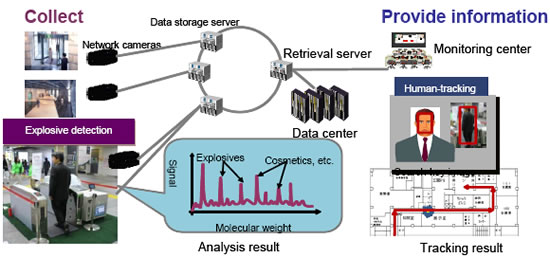Information contained in this news release is current as of the date of the press announcement, but may be subject to change without prior notice.
December 2, 2010
Tokyo, December 2, 2010 --- Hitachi, Ltd. (NYSE:HIT / TSE:6501) today announced the development of technology to track the movement and current location of the person from whose clothing or baggage explosive compounds (homemade explosive*1) have been detected, using a walk-through style explosive detection equipment and surveillance camera network. This technology was achieved through the combination of the Hitachi original explosives detection equipment with high-speed similar-image retrieval technology,*2 and a newly developed search algorithm which repeatedly detects the image of the person whom explosive compounds were detected from surveillance camera data in the facility. Using this technology, it is now possible to detect the presence of explosive compounds and track the movement of the person carrying the compounds in busy places such as stations and event halls without disrupting the pedestrian flow.
In recent years, as public concern for safety and security rises, technology is being developed to introduce the high level security technology currently being used in limited facilities such as airports to other facilities used by an unspecified number of people such as railway stations and event halls.
Since 2007, Hitachi has been participating in the MEXT*3“Project on Science and Technology for a Safe and Secure Society” to pursue the development of a walk-through style explosives detection equipment which can detect the explosive compounds from homemade bombs on clothing or baggage within three seconds based on highly sensitive mass spectrometry. The equipment which reduced the detection time required from approximately 20 seconds to less than one-sixth, was considered viable technology for providing high security without disrupting the flow of people. One issue however was that by 3 seconds, when the detection results became available, the person measured would have already moved a distance of approximately 3 meters. In order to provide truly undisruptive operation, a system which could reliably track the person’s location after proceeding through the walk-through equipment was necessary.
To solve this, Hitachi applied its high-speed similar-image retrieval technology which can search 10 million images in just one second to the walk-through style explosives detection equipment by using the image of the person from whom explosive compounds were detected. A repetitive search for the target image in the image data stream from the numerous surveillance cameras in a facility was conducted based a newly developed search algorithm, enabling the target to be tracked in real-time after detection. From the position of the camera and the time stamp on the image data, it is then possible to track in real-time the route taken throughout a facility as well as establish the person’s current location. This technology is expected to contribute to the achievement of a high-level of security in facilities and places frequented by a large number of people, such as stations and event halls, without disrupting the flow of people.
The results of this research will be presented at the IEICE Pattern Recognition & Media Understanding Workshop to be held at Yamaguchi University, Japan, from 9th - 10th December 2010.

Hitachi, Ltd., (NYSE:HIT / TSE:6501), headquartered in Tokyo, Japan, is a leading global electronics company with approximately 360,000 employees worldwide. Fiscal 2009 (ended March 31, 2010) consolidated revenues totaled 8,968 billion yen ($96.4 billion). Hitachi will focus more than ever on the Social Innovation Business, which includes information and telecommunication systems, power systems, environmental, industrial and transportation systems, and social and urban systems, as well as the sophisticated materials and key devices that support them. For more information on Hitachi, please visit the company's website at http://www.hitachi.com.